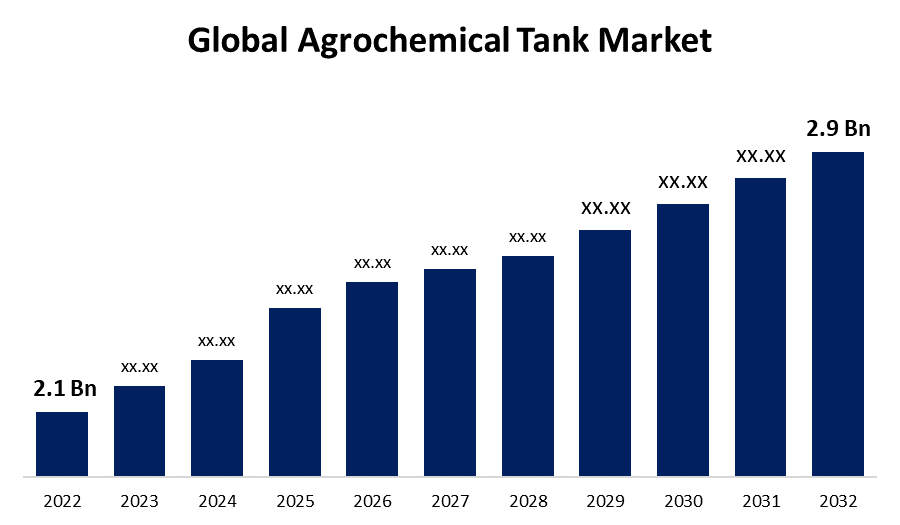Global Agrochemical Tank Market Size To Worth USD 2.9 Billion by 2032. | CAGR of 5.3%
Category: Chemicals & MaterialsGlobal Agrochemical Tank Market Size To Worth USD 2.9 Billion by 2032.
According to a research report published by Spherical Insights & Consulting, The Global Agrochemical Tank Market Size to grow from USD 2.1 billion in 2022 to USD 2.9 billion by 2032, at a Compound Annual Growth Rate (CAGR) of 5.3% during the forecast period.

Get more details on this report -
Browse key industry insights spread across 210 pages with 100 market data tables and figures & charts from the report on the "Global Agrochemical Tank Market Size, Share, and COVID-19 Impact By Type (Conical, Vertical, Horizontal), By Size (200-500 Liters, 500-1,000 Liters, 1,000-15,000 Liters, 15,000-30,000 Liters, >30,000 Liters), By Application (Water Storage, Fertilizer Storage, Chemical Storage), By Region (North America, Europe, Asia-Pacific, Latin America, Middle East, and Africa), Analysis and Forecast 2022 – 2032." Get Detailed Report Description Here: https://www.sphericalinsights.com/reports/agrochemical-tank-market
Agrochemical tank containers, also referred to as chemical sprayers or pesticide tanks, are used to transport and store agrochemicals such as pesticides, herbicides, fungicides, and fertilisers. These tanks enable farmers and agricultural workers to apply various chemicals to crops for weed control, disease prevention, pest control, and nutritional supplementing. Typically, agrochemicals are spread evenly throughout a field using sprayers or tractors that have agrochemical tanks installed on them. The tanks are designed to hold liquid agrochemical solutions and frequently have components that ensure accurate mixing, metering, and application of the chemicals. An agrochemical tank is often made of hardy materials like polyethylene or fibreglass to withstand corrosion and chemical reactions with the contents.
COVID 19 Impact
Due to travel restrictions, the closure of production facilities, and transportation issues, the agrochemicals sector, like many other industries, experienced supply chain delays. As a result, the production and delivery of agrochemical products were delayed. The agrochemicals sector heavily depends on labour for both production and farm work. Lockdowns and travel restrictions caused a worker shortage, which had an effect on industry and agricultural operations. Many clients experienced lower discretionary money as a result of the pandemic's effects on the economy. This could affect the demand from consumers for pricey agricultural products that require agrochemical inputs. Due to movement restrictions and limited transportation capacity, it was difficult to get agrochemical products to farmers, possibly leading to shortages in some places.
As the world's population expands, there is a growing demand for food production. The crucial role that agrochemicals, such as fertilisers and insecticides, play in enhancing crop yields and protecting crops from pests and diseases supports the need for expanding agricultural output. Agrochemical use has been more efficient and targeted thanks to advancements in agricultural technology such as precision farming, biotechnology, and digital farming tools. These innovations can increase agricultural productivity while lessening the harm they cause to the environment. Agricultural intensification is frequently necessary to meet the world's food needs because arable land is so scarce. Agrochemicals improve crop health and soil fertility, optimising the use of currently available acreage. As consumer requirements and eating habits change, a range of crops are becoming more essential. More and more developing countries are learning the benefits of using agrochemicals to increase agricultural productivity. As these markets grow, there is a potential that agrochemical use will increase.
To safeguard the environment and public health, agrochemicals must abide by stringent regulations. Agrochemical tank manufacturers are required to comply with laws governing material composition, chemical compatibility, labelling, and safety features. Keeping up with the various regions' shifting legal requirements can be difficult and expensive. Agrochemicals come in many different formulations, each with its own special chemical properties. Agrochemical tank materials must be compatible with a range of chemicals in order to prevent chemical reactions, deterioration, or contamination of the stored materials. It might be challenging to build tanks that are appropriate for various chemicals. It can be challenging to construct tanks that are durable and corrosion-resistant over time since agrochemicals can be corrosive.
Type Insights
Vertical Tanks is dominating the market with the largest market share
On the basis of type, the global agrochemical tank market is segmented into Conical, Vertical, and Horizontal. Among these, the vertical tanks is dominating the market with the largest market share over the forecast period. The growing demand for agricultural products on a global scale and the need to boost agricultural productivity are the driving forces behind the need for efficient and affordable storage technologies, such as vertical tanks. To prevent leaks and spills that could harm the environment, spill containment components are typically used while building vertical tanks. As the need for environmental sustainability grows increasingly urgent, vertical tanks that prioritise containment and minimise environmental impact are necessary. High-quality vertical tanks made of durable materials can have a longer lifespan and provide a solid solution for long-term agrochemical storage needs.
Size Insights
15,000-30,000 Liters holds the highest market share over the forecast period
Based on the size, the global agrochemical tank market is segmented into 200-500, 500-1,000, 1,000-15,000, 15,000-30,000, and >30,000 Liters. Among these, 15,000-30,000 litres segment holds the highest market share over the forecast period. The development of this market segment is influenced by a variety of factors, including technology advancements, governmental changes, and customer preferences. In order to retain the volume of agrochemicals necessary for effective crop management, larger tanks are usually required for agricultural operations that cover larger regions and involve higher crop output quantities. Larger tanks allow for the storage of more agrochemicals, which decreases the need for frequent refilling and enables more productive application operations. Sometimes investing in larger tanks might save money on manufacturing, shipping, and transporting. As a result, larger tanks can be more inexpensive for both users and producers. Precision agriculture technology development requires the effective distribution and storage of agrochemicals.
Application Insights
Water storage tanks segment dominates the market over the forecast period
On the basis of application, the global agrochemical tank market is segmented into Water Storage, Fertilizer Storage, and Chemical Storage. Among these, water storage segment dominates the market with the largest market share over the forecast period. The growth of the water storage segment in the agrochemical tank market is influenced by a variety of agricultural practises, climate, water availability, and technological advancements. If agriculture is to be fruitful, irrigation systems must be efficient. During periods of heavy rainfall, farmers can collect and store water in water storage tanks, ensuring a reliable water source for irrigation during dry spells. In places with limited water supplies, water storage tanks provide a technique to effectively manage and conserve water resources. Water storage tanks help farmers plant a wider range of crops with diverse water requirements, which improves agricultural diversification and market responsiveness.
Regional Insights
Asia Pacific is dominating the market with the largest market share over the forecast period

Get more details on this report -
Asia Pacific is dominating the market with the largest market share over the forecast period. Asia-Pacific contains a few of the world's most populous countries, such as China and India. Agrochemicals, especially agrochemical tanks as a storage alternative, are highly needed in these countries due to the huge agricultural sectors. Population development has increased the region's need for higher food production. Agrochemicals are necessary to boost agricultural yield and ensure food security. Growing middle classes in many Asian nations have changed nutritional preferences, which has increased demand for a variety of commodities. This increases the need for effective agrochemical storage and application.
North America is witnessing the fastest market growth over the forecast period. North America's agriculture sector is highly developed and technologically advanced, particularly in the United States and Canada. This region produces a substantial amount of the world's crops, including grains, oilseeds, fruits, and vegetables. There are many distinct sorts of agricultural operations in North America, ranging from large commercial farms to relatively modest family-run enterprises. Due to this diversity, there are many different types of agrochemicals and related machinery that are required. Environmental responsibility and sustainable agricultural practises are getting greater attention.
Market Segment
This study forecasts revenue at global, regional, and country levels from 2019 to 2032. Spherical Insights has segmented the global Agrochemical Tank Market based on the below-mentioned segments:
Agrochemical Tank Market, Type Analysis
- Conical
- Vertical
- Horizontal
Agrochemical Tank Market, Size Analysis
- 200-500 litres
- 500-1,000 litres
- 1,000-15,000 litres
- 15,000-30,000 litres
- >30,000 Liters
Agrochemical Tank Market, Application Analysis
- Water Storage
- Fertilizer Storage
- Chemical Storage
Agrochemical Tank Market, Regional Analysis
- North America
- US
- Canada
- Mexico
- Europe
- Germany
- Uk
- France
- Italy
- Spain
- Russia
- Rest of Europe
- Asia Pacific
- China
- Japan
- India
- South Korea
- Australia
- Rest of Asia Pacific
- South America
- Brazil
- Argentina
- Rest of South America
- Middle East & Africa
- UAE
- Saudi Arabia
- Qatar
- South Africa
- Rest of Middle East & Africa
About the Spherical Insights & Consulting
Spherical Insights & Consulting is a market research and consulting firm which provides actionable market research study, quantitative forecasting and trends analysis provides forward-looking insight especially designed for decision makers and aids ROI.
Which is catering to different industry such as financial sectors, industrial sectors, government organizations, universities, non-profits and corporations. The company's mission is to work with businesses to achieve business objectives and maintain strategic improvements.
CONTACT US:
For More Information on Your Target Market, Please Contact Us Below:
Phone: +1 303 800 4326 (the U.S.)
Phone: +91 90289 24100 (APAC)
Email: inquiry@sphericalinsights.com, sales@sphericalinsights.com
Contact Us: https://www.sphericalinsights.com/contact-us
Need help to buy this report?